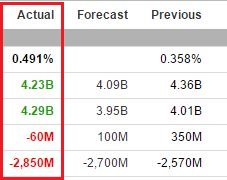ช่วงกลาง ๆ ของปี 1300s สาธารณรัฐฟลอเรนซ์ หรืออิตาลีในปัจจุบัน เกิดอาการบูมทางเศรษฐกิจแบบฉุดไม่อยู่ ...สุด ๆ ในประวัติศาสตร์มนุษยชาติกันเลย ในชั่วไม่ถึงศตวรรษ ฟลอเรนซ์เติบโตขึ้นจากเมืองเล็ก ๆ ที่อยู่หลังเขา กลายเป็นเมืองใหญ่ที่สุดในยุโรป
และเป็นศูนย์กลางการเงินที่โดดเด่นสุด ๆ ประชากรของฟลอเรนซ์เพิ่มเป็น 10 เท่า ...มีความเด่นในการผลิตอาวุธ และสิ่งทอ
(ผู้เชี่ยวชาญทางภาษาเชื่อว่า คำว่า pistol (ปืนพก) มาจากชื่อเมืองแห่งหนึ่งในฟลอเรนซ์คือ Pistoia ชื่งมีชื่อเสียงด้านการผลิตอาวุธ)
นวัตกรรมด้านธุรกิจแบ้งกิ้งของฟลอเรนซ์ทำให้เกิดการเปลี่ยนแปลงในธุรกิจทั่วทั้งยุโรปยุคนั้น
ความสำเร็จทางเศรษฐกิจที่โดดเด่นของฟลอเรนซ์เหมือนกับสหรัฐอเมริกาในประวัติศาสตร์ยุคแรก ๆ
แต่แล้ว..พวกเขาก็พังมันลงจนได้
ในช่วงต้น ๆ ของยุค 1300 หนี้สาธารณะของสาธารณรัฐฟลอเรนซ์อยู่ในระดับที่จัดการได้ แค่ 50,000 gold florins ...นั่นมันน้อยกว่า $100 ต่อหัว ถ้าคิดในอัตราเงินปัจจุบัน
ปี 1338 หลังจากใช้เงินในการทำสงครามแบบเป็นซีรี่ส์ และโปรเจ็คท์งานสาธารณูปโภคที่แสนแพง หนี้ของฟลอเรนซ์กลายเป็นบัลลูนขึ้นไปถึง 450,000 gold florins ...หลังจากนั้น 4 ปี และอีก 1 สงคราม ก็กลายเป็น 600,000 gold florins
มันแทบทำให้สาธารณชนเป็นง่อยไปเลย เพราะรัฐบาลจ่ายได้แค่ดอกเบี้ยที่สูงถึง 10% - 15%
ที่แสบไปกว่านั้น หลายแบ้งค์ใหญ่ของฟลอเรนซ์ยังไปปล่อยกู้ให้กับรัฐบาลต่างประเทศ ..รายใหญ่เลยก็คือคิงเอ็ดเวิร์ดที่สามของอังกฤษ ที่กำลังแพ้สงครามกับฝรั่งเศส ในสงครามที่เรียกว่า "สงครามร้อยปี"
สุดท้ายแล้ว คิงเอ็ดเวิร์ดก็ชักดาบหนี้ทั้งหมดของแบ้งค์อิตาเลียน เป็นการจุดชนวนวิกฤตแบ้งกิ้งในฟลอเรนซ์
ข่าวกระจายอย่างรวดเร็วว่า ศูนย์กลางการเงินที่แข็งแกร่งที่สุดของยุโรปกำลังจะเจ๊ง รัฐบาลก็ใกลัพังเต็มทน ธนาคารก็กำลังจะ collapse
แถมก็ยังมีกาฬโรคตามมาอีก ....เวรกรรม
ปี 1348 กาฬโรคระบาดเข้าฟลอเรนซ์ คร่าชีวิตประชากรไป 25%
ธุรกิจการค้าพังพาบ การเก็บภาษีเป็นศูนย์ รัฐบาลฟลอเรนซ์ไม่สามารถจ่ายหนี้
Giovanni Villani นักการเมืองยุคนั้นอธิบายถึงสถานการณ์ ...."ประเทศเรากำลังสูญเสียทุกอย่างแล้ว ประชาชนทั้งประเทศกำลังกลายเป็นยาจกในพริบตา"
แล้วที่น่าอัศจรรย์ยิ่งกว่านั้นคือ มันไม่ได้หยุดอยู่แค่ฟลอเรนซ์
ในปลายช่วง 1340s ฝนตกหนักจนเกิดน้ำท่วมที่ทำลายผลผลิตทางการเกษตรไปทั่ว ส่งผลให้เกิดทุพภิกขภัยเป็นวงกว้าง
ผู้บริหารรัฐพยายามอย่างสิ้นหวังที่จะสั่งนำเข้าอาหาร แต่เครดิตของฟลอเรนซ์ไม่เหลือแล้ว ไม่มีใครอยากเป็นคู่ค้าด้วยอีกแล้ว
เป็นการร่วงจากอำนาจแบบเป็นประวัติการณ์ที่ไม่เคยมีมาก่อน ฟลอเรนซ์ร่วงจากประเทศที่ร่ำรวยที่สุดในยุโรปมาเป็นขอทานภายในเวลาชั่วหนึ่งทศวรรษ
ทำให้ผมเริ่มอยากรู้แล้วว่า ในยุควิกฤตโมเดอร์นอย่างเวลานี้ ประเทศไหนจะกลายเป็นขอทาน ในแบบที่ฟลอเรนซ์เป็นเมื่อยุค 1300s บ้าง....เท่าที่ดูแล้วผมประมาณได้นับโหล ๆ ที่กำลังเจอกับปัญหาการเงินขนาดหนัก ภายใต้โรคระบาด
ตอนนี้รายรับภาษีของประเทศเหล่านี้ก็หดตัวลง แต่ก็ยังจำต้องใช้จ่ายเงินเพื่อกระตุ้นให้เศรษฐกิจยังเดินหน้าต่อไปให้ได้
เราเห็นแพกเกจการกระตุ้นกำลังเกิดขึ้นทุกประเทศทั่วโลก
ในสหรัฐเอง รัฐบาลผ่านกฏหมายแผนกระตุ้นเศรษฐกิจ $2 ล้านล้าน ...ซึ่งผมคิดว่าก็คงซื้อเวลาไปได้ซัก 4 - 6 สัปดาห์แค่นั้นแหละ
แล้วถ้าโรคระบาดนี้มันลากยาวยืดเยื้อไปเรื่อย ๆ ก็คงต้องมีการใช้เงินอีก $2 ล้านล้าน ...และก็อีก $2 ล้านล้าน ยาวไปโลด
ถ้ายังไม่ลืม รัฐบาลสหรัฐได้เพิ่มหนี้ไว้ $10 ล้านล้านในช่วงไม่กี่ปีแรกหลังจากวิกฤตการเงินครั้งล่าสุด มันก็คงเกิดซ้ำซากไปแบบนี้แหละ
บางประเทศก็สามารถใช้เงินมหาศาลขนาดนี้ได้
เช่นอย่างนอร์เวย์ซึ่งมีหนี้สาธารณะเป็นศูนย์ รัฐบาลนอร์เวย์มีเงินเหลือในคลังมากพอที่จะบอกกับประชาชนว่า "จงอยู่ที่บ้านแล้วไม่ต้องทำอะไรไปอีกสักหกเดือนได้เลย ....จะซื้อของใช้ก็แค่เขียนเช็คจ่ายไป" ...รัฐบาลมีเงินให้ประชาชนของตนใช้ได้โดยไม่ต้องสร้างหนี้เลย
แต่กับอิตาลีแล้ว เป็นคนละเรื่องเลย ...ฐานะการเงินแย่สุดๆ (a basket case)
รัฐบาลอิตาลีไม่เคยมีเงินเหลือในคลังเลย ภาระหนี้ของประเทศถึงแม้ก่อนเกิดวิกฤตไวรัส ก็ปาเข้าไปเกินกว่า 120% ของ GDP อยู่แล้ว
ยิ่งกว่านั้น ธนาคารในประเทศเองแกว่งตัวอยู่บนขอบของความพินาศก่อนที่ไวรัสจะมาถึงซะอีก ป่านนี้คิดว่าแบ้งค์พวกนี้ก็คงเจ๊งกันไปหมดแล้ว
ถ้าจะให้ทำ forecast ตอนนี้ก็คงจะยากน่าดู ...เอาทุก scenario มากางบนโต๊ะได้เลย ...ทุก scenario เกิดขึ้นได้ทั้งนั้น
ประเทศที่มีหนี้หนักสุดดูเหมือนจะเป็นประเทศที่อยู่ใน big trouble สุดๆ .....เราคงต้องได้เห็น วิกฤตหนี้สาธารณะในหลาย ๆ ประเทศแน่ ๆ ในช่วงไม่กี่เดือนจากนี้
Sovereign Man
There’s a major sovereign debt crisis looming
Simon Black April 2, 2020
By the mid 1300s, the Republic of Florence in modern day Italy had experienced one of the greatest economic booms in human history.
In less than a century, Florence had grown from a tiny, irrelevant backwater to become one of Europe’s largest cities and preeminent financial center.
The expansion was truly impressive. Florence’s population had grown 10x. It had become a leading manufacturer in both weapons and textiles.
(Many etymologists believe the word ‘pistol’ is derived from the name of a town near Florence called Pistoia, which was renowned for its quality arms.)
And the city’s innovations in the banking industry were revolutionizing business across Europe.
Florence’s phenomenal economic success is quite similar to what the United States experienced in its early history.
Naturally, though, they managed to screw it up.
At the turn of the century in the year 1300, the Republic of Florence’s public debt was quite manageable at just 50,000 gold florins. That’s less than $100 per capita in today’s money.
By 1338, after a series of costly wars and expensive public works projects, Florence’s debt had ballooned to 450,000 gold florins. Four years later (after yet another war) it had grown to 600,000 gold florins.
This was crippling to public finances given that the government of Florence was paying between 10% and 15% interest on its debt.
To make matters worse, some of Florence’s most prominent banks had made bad loans to foreign governments– most notably to King Edward III of England, who had suffered terrible defeat against France in what would become known as the Hundred Years War.
Edward would ultimately default on his Italian bank loans, sparking a terrible banking crisis in Florence.
News traveled quickly that the most powerful financial center in Europe was in trouble. The government was near ruin, and the banks were collapsing.
And then came the plague.
In 1348, the Black Death ravaged Florence, wiping out at least 25% of its population. The famed Italian author Giovanni Boccaccio was living in the city at the time, and he wrote about his first-hand experiences in the Decameron:
“[S]uch terror was struck into the hearts of men and women by this calamity, that brother abandoned brother, and the uncle his nephew, and the sister her brother, and very often the wife her husband. What is even worse and nearly incredible is that fathers and mothers refused to see and tend their children, as if they had not been theirs.”
Business and commerce ground to a halt. Tax revenue dried up. Florence’s government was unable to pay its debts. People were wiped out.
As local politician Giovanni Villani described the situation, “Our republic has lost all its power and our citizens have nearly all been impoverished.”
Amazingly enough, Florence’s misfortune didn’t stop there.
In the late 1340s, torrential rains destroyed local agricultural production, resulting in widespread famine.
City managers tried desperately to import food, but because Florence’s credit was so poor, few traders were willing to do business with them.
It was a historic and unprecedented fall from power; Florence had gone from being one of the wealthiest cities in Europe to literally begging for food in less than a decade.
I can’t help but wonder which countries are going to be begging as a result of our modern crisis.
Just like Florence in the 1300s, there are dozens of countries who were already in severe financial hardship going into this pandemic.
Now their tax revenues are dwindling, and they’re forced to spend absurd amounts of money to stimulate their economies.
A few years back our holding company acquired a private business in Australia that, thankfully, is holding up extremely well.
The CEO of that company called me a few days ago to tell me about some of Australia’s stimulus efforts; in addition to waiving payroll taxes, extending tax deadlines, and making direct loans to businesses, the Australian government is now directly subsidizing certain employee wages, up to $3,000 per month.
We’re seeing similar stimulus packages all over the world.
In the United States, of course, the government recently passed a $2 trillion stimulus plan… though I expect they’ll quickly realize that $2 trillion buys them about 4-6 weeks.
So if this pandemic drags on, they’re going to have to spend another $2 trillion, and another $2 trillion after that.
Remember that US government debt increased by $10 trillion in the first few years following the last financial crisis. It certainly seems reasonable to expect a repeat performance.
Some places will be able to afford such prodigious spending.
Norway, for example, has ZERO net debt. Norway’s government has such a massive financial surplus that they could tell every citizen, “Stay home and do nothing for the next six months,” and just write a check for everything. They wouldn’t need to go into debt by a single penny.
Italy, on the other hand, is a basket case.
The Italian government has no savings, and its debt burden even before this crisis was more than 120% of GDP.
Moreover, Italian banks were also teetering on the edge of disaster before the pandemic hit. I suspect most of them are completely insolvent now.
Making any forecast right now is remarkably difficult. Every scenario is on the table, and absolutely anything can happen.
But it seems pretty clear that the most heavily indebted countries are in big trouble… and we may be looking at a major sovereign debt crisis over the next few months.
Simon Black April 2, 2020
Cr.Sayan Rujiramora
เพิ่มเพื่อนรับข่าวสารตลาดหุ้น Forex และบทความดีๆ ด้านการเงิน การลงทุน ฟรี !!
http://line.me/ti/p/%40zhq5011b
Line ID:@fxhanuman
Web : https://www.fxhanuman.com
Web : https://www.eluforex.com/
FB:https://www.facebook.com/review.forex.broker/
เยี่ยมชม partner ของเราที่ Eluforex รีวิวโบรกเกอร์ Forex
#forex #ลงทุน #peppers #xm #fbs #exness #uag #icmarkets #avatrade #fxtm #tickmill #fxpro #fxopen #fxcl #forex3d #forex4you





